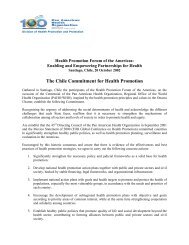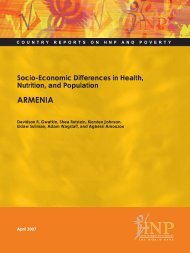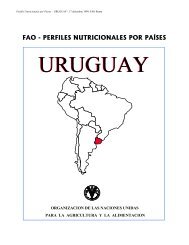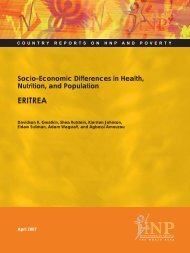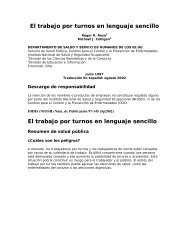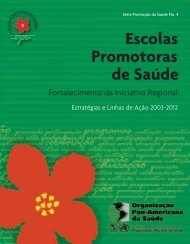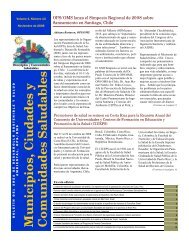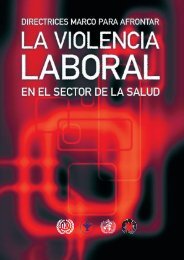Guidelines for drinking-water quality. Volume 1 - BVSDE
Guidelines for drinking-water quality. Volume 1 - BVSDE
Guidelines for drinking-water quality. Volume 1 - BVSDE
Create successful ePaper yourself
Turn your PDF publications into a flip-book with our unique Google optimized e-Paper software.
the <strong>quality</strong> of <strong>drinking</strong>-<strong>water</strong> may be degraded to the recommended level. Indeed, a continuous<br />
ef<strong>for</strong>t should be made to maintain <strong>drinking</strong>-<strong>water</strong> <strong>quality</strong> at the highest possible level.<br />
(e) Short-term deviations above the guideline values do not necessarily mean that the <strong>water</strong> is<br />
unsuitable <strong>for</strong> consumption. The amount by which, and the period <strong>for</strong> which, any guideline value<br />
can be exceeded without affecting public health depends upon the specific substance involved. It<br />
is recommended that when a guideline value is exceeded, the surveillance agency (usually the<br />
authority responsible <strong>for</strong> public health) should be consulted <strong>for</strong> advice on suitable action, taking<br />
into account the intake of the substance from sources other than <strong>drinking</strong>-<strong>water</strong> (<strong>for</strong> chemical<br />
constituents), the toxicity of the substance, the likelihood and nature of any adverse effects, the<br />
practicability of remedial measures, and similar factors.<br />
(f) In developing national <strong>drinking</strong>-<strong>water</strong> standards based on these guideline values, it will be<br />
necessary to take account of a variety of geographical, socioeconomic, dietary, and other<br />
conditions affecting potential exposure. This may lead to national standards that differ appreciably<br />
from the guideline values.<br />
(g) In the case of radioactive substances, screening values <strong>for</strong> gross alpha and gross beta activity<br />
are given, based on a reference level of dose.<br />
It is important that recommended guideline values are both practical and feasible to implement as<br />
well as protective of public health. Guideline values are not set at concentrations lower than the<br />
detection limits achievable under routine laboratory operating conditions. Moreover, guideline<br />
values are recommended only when control techniques are available to remove or reduce the<br />
concentration of the contaminant to the desired level.<br />
In some instances, provisional guideline values have been set <strong>for</strong> constituents <strong>for</strong> which there is<br />
some evidence of a potential hazard but where the available in<strong>for</strong>mation on health effects is<br />
limited. Provisional guideline values have also been set <strong>for</strong> substances <strong>for</strong> which the calculated<br />
guideline value would be (i) below the practical quantification level, or (ii) below the level that can<br />
be achieved through practical treatment methods. Finally, provisional guideline values have been<br />
set <strong>for</strong> certain substances when it is likely that guideline values will be exceeded as a result of<br />
disinfection procedures.<br />
Aesthetic and organoleptic characteristics are subject to individual preference as well as social,<br />
economic, and cultural considerations. For this reason, although guidance can be given on the<br />
levels of substances that may be aesthetically unacceptable, no guideline values have been set<br />
<strong>for</strong> such substances where they do not represent a potential hazard to health.<br />
The recommended guideline values are set at a level to protect human health; they may not be<br />
suitable <strong>for</strong> the protection of aquatic life. The guidelines apply to bottled <strong>water</strong> and ice intended<br />
<strong>for</strong> human consumption but do not apply to natural mineral <strong>water</strong>s, which should be regarded as<br />
beverages rather than <strong>drinking</strong>-<strong>water</strong> in the usual sense of the word. The Codex Alimentarius<br />
Commission has developed Codex standards <strong>for</strong> such mineral <strong>water</strong>s.<br />
1.3 Criteria <strong>for</strong> the selection of health-related <strong>drinking</strong>-<strong>water</strong> contaminants<br />
The recognition that faecally polluted <strong>water</strong> can lead to the spread of microbial infections has led<br />
to the development of sensitive methods <strong>for</strong> routine examination to ensure that <strong>water</strong> intended <strong>for</strong><br />
human consumption is free from faecal contamination. Although it is now possible to detect the<br />
presence of many pathogens in <strong>water</strong>, the methods of isolation and enumeration are often<br />
complex and time-consuming. It is there<strong>for</strong>e impracticable to monitor <strong>drinking</strong>-<strong>water</strong> <strong>for</strong> every<br />
possible microbial pathogen. A more logical approach is the detection of organisms normally<br />
present in the faeces of humans and other warm-blooded animals as indicators of faecal<br />
pollution, as well as of the efficacy of <strong>water</strong> treatment and disinfection. The various bacterial




